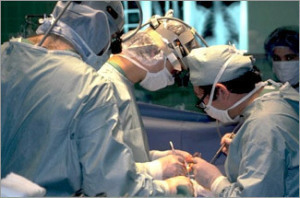Wide geographic variation seen in stroke-prevention procedure
by
Brendon Nafziger, DOTmed News Associate Editor | August 02, 2010

Different ways to prevent
strokes, for different folks.
Wide geographic variation was found in two procedures to prevent stroke from diseased carotid arteries, according to a government report.
In a study published last week and commissioned by the Agency for Healthcare Research and Quality (AHRQ), researchers examined all claims filed for Medicare beneficiaries who underwent the procedures, carotid endarterectomy and carotid stenting, between 2003 and 2006.
In carotid endarterectomy, doctors surgically remove plaque from diseased carotid arteries, the blood vessels that carry blood to the brain. Stenting involves inserting a wire mesh into the arteries to keep the blood flowing, and is used in patients deemed unfit for the other procedure, the report said. Stenting was approved by Medicare, only for high-risk patients, in 2004.
In the report, widespread regional variation with the procedures was found, with parts of the South and Midwest having the highest rates.
"The New England, Mountain, and Pacific regions tended to have the lowest rates of both procedures, whereas the East South Central, West South Central, East North Central, and West North Central regions tended to have higher rates of revascularization," said the report, led by Dr. Manesh R. Patel and based on Duke University research.
According to the report, there was nearly a sevenfold difference in carotid endarterectomy rates in the most recent years studied, 2005 and 2006, between the lowest rate and highest rate regions. Beaumont, Texas, with 5.5 per 1,000 person-years, was the highest, and Honolulu, Hawaii, with 0.8 per 1,000 person-years, was the lowest.
Variation also applied to the diagnostic imaging modality chosen by doctors to help diagnose blocked carotid arteries.
Prior to carotid endarterectomies, most patients, about one-third, had the procedure preceded by ultrasound and x-ray angiography, while 27 percent had ultrasound and magnetic resonance angiography.
Controversially, another 27 percent had the procedure done based on ultrasound alone. For stenting, about 10 percent had only ultrasound, the report said.
Relying only on ultrasound scans is tricky, the report said, as previous research has suggested it can misclassify up to 28 percent of patients.
Nonetheless, a recent survey of Canadian surgeons found one out of ten neurosurgeons, and about half of vascular surgeons, said ultrasound alone was sufficient for diagnosis.
"Our findings highlight the need for consensus regarding diagnostic imaging criteria for the identification and management of carotid artery disease," the authors write.
